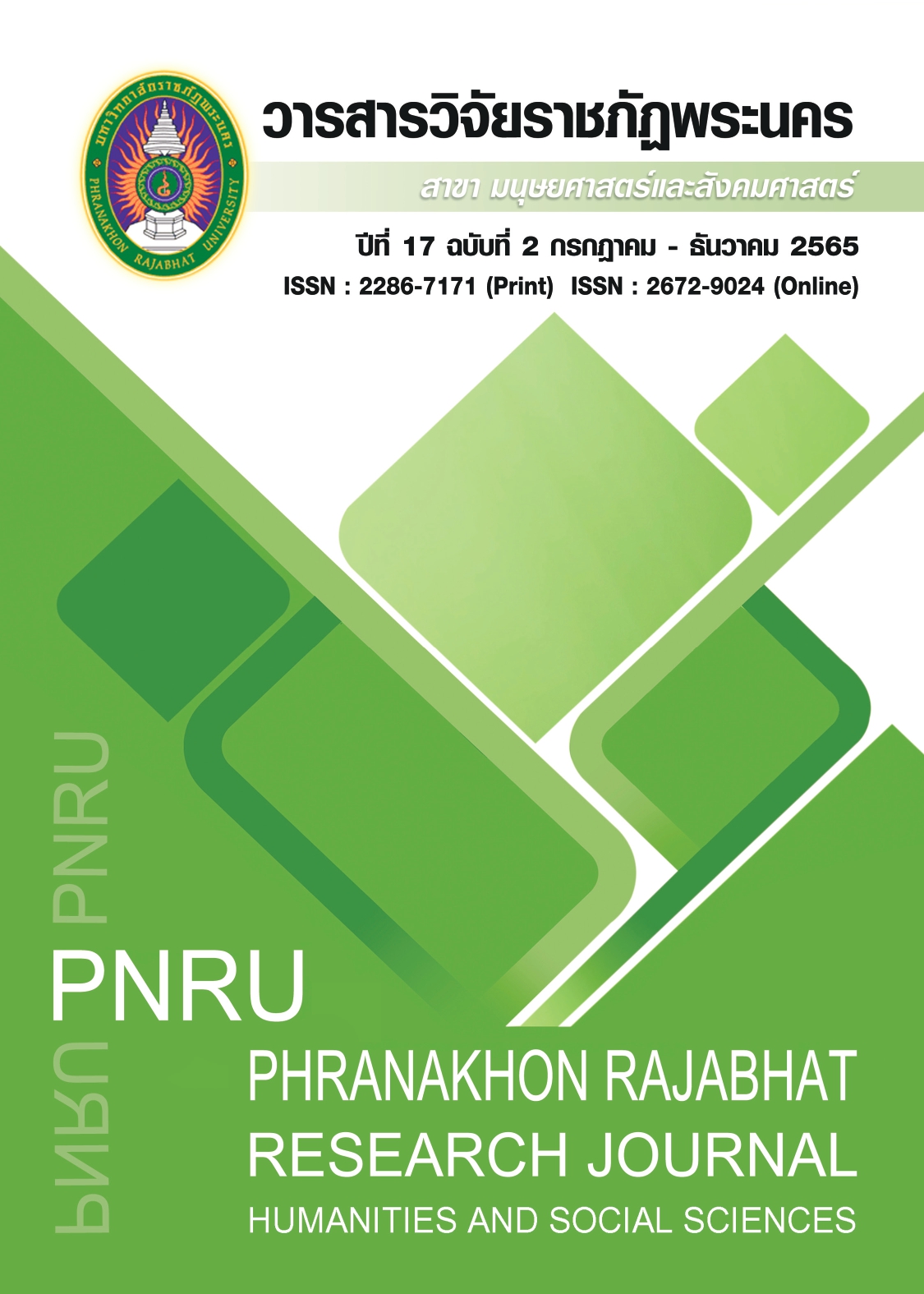VILLAGE PHILOSOPHERS’ ROLES IN CREATIVE ENTREPRENEUR : A CASE STUDY OF BAN BATRA COMMUNITY, POMPRAPSATTRUPHAI DISTRICT IN BANGKOK
Main Article Content
Abstract
In the creative industry of Thailand, there is a cultural heritage that is passed on knowledge from entrepreneurs in the community who have accumulated experience in passing on wisdom from generation to generation. The aim was to study 1) the role of creative community entrepreneurs: a case study of Ban Batra community products 2) A study on the transmission of knowledge about alms in today’s society 3) Propose guidelines for the role of creative community entrepreneurs in ensuring long-term sustainability. The key informants used in the study were 20 people. One community chairperson, two community vice-chairmen, four community committee members, twelve community entrepreneurs, and one village scholar. The research tool was an in-depth interview form. The results of the study found that 1) the issue of the role of creative community entrepreneurs had internal and external factors, 2) the issue of knowledge transfer was found to be transmitted through public relations media both online and offline, and 3) the issue of guidelines for the role of creative community entrepreneurs for social sustainability. It was found that building a network between both the public and private sectors will play an important role in creating sustainability; creating a new generation who will carry on the ancient wisdom of making monk’s alms bowls.
Article Details

This work is licensed under a Creative Commons Attribution-NonCommercial-NoDerivatives 4.0 International License.
Each publish articles were copyright by Phranakorn Rajabhat University
Any contents which appeared in each articles in the journal were authors personal opinion. It did not relate to Phranakorn Rajabhat University and other instructors in the university. Each authors would take responsibility on their articles. If there are any mistake, the authors will take responsibility themselves
References
Announcement of Established the Creative Economy Agency (Public Organization): CEA. (2018, August 13). Government Gazette. No. 135 Section 59 A. page 27-43.
Athwal, N., Istanbulluoglu, D., & McCormack, S. E. (2019). The allure of luxury brands’ social media activities: a uses and gratifications perspective. Information Technology & People, 32(3), 603-626
Bakas, F. E., Duxbury, N., & de Castro, T. V. (2018). Creative tourism: Catalysing artisan entrepreneur networks in rural Portugal. International Journal of Entrepreneurial Behavior & Research.
Bujor, A., & Avasilcai, S. (2015). Creative Industries as a Growth Driver: An Overview. MakeLearn 2015: Managing Intellectual Capital and Innovation for Sustainable and Inclusive Society (pp. 1725-1731). Bari: ToKnowPress, Bangkok • Celje • Lublin.
Bujor, A., & Avasilcai, S. (2016). The creative entrepreneur: A framework of analysis. Procedia-Social and Behavioral Sciences, 221, 21-28.
Bocconcelli, R., Cioppi, M., & Pagano, A. (2017). Social media as a resource in SMEs’ sales process. Journal of Business & Industrial Marketing, 32(5), 693-709.
Chang, Y. Y., & Chen, M. H. (2020). Creative entrepreneurs’ creativity, opportunity recognition, and career success: Is resource availability a double-edged sword?. European Management Journal, 38(5), 750-762.
Creative Economy Agency. (2020). Creative Economy takes the Thai economy forward to the international. Retrieved April 30, 2022, from https://www.nxpo.or.th/th/9440/
Culture Sport and Tourism Department. (2022). Culture Division. Retrieved April 30, 2022, from http://tinyurl.mobi/tzxd
Dana, L. P., & Salamzadeh, A. (2021). Why do artisans and arts entrepreneurs use social media platforms?: Evidence from an emerging economy. Nordic Journal of Media Management, 2(1), 23-35.
Fattah, A., Syairozi, M. I., & Rohimah, L. (2021). “YOUTH CREATIVE ENTERPRENEUR EMPOWERMENT (YOUTIVEE)”: Solutions for Youth to Contribute to the Economy and Reduce Unemployment. International Journal of Economics, Business and Accounting Research (IJEBAR), 5(3).
Hudson, S., & Hudson, R. (2013). Engaging with consumers using social media: a case study of music festivals. International Journal of Event and Festival Management, 4(3), 206-223.
Kruthngam, A. (2015). The Handicraft Curriculum Development of Kubua woven frabric along the creative economy for seventh grade students. Viridian E-Journal, Silpakorn Univesity. 8(2), 352-371.
Mutchima, P., Phiwma, N., & Valeepitakdej, V. (2019). E-Commerce for the Preservation of Traditional Thai Craftsmanship. In 2019 4th International Conference on Information Technology (InCIT) (pp. 114-119). IEEE.
Patten, T. (2016). " Creative?"…" Entrepreneur?"–Understanding the Creative Industries Entrepreneur. Artivate, 5(2), 23-42.
Pattarajierapan, S. (2013). Management of alms bowl handmaking as a learning center a case of Thai traditional handicrafts. (Doctoral dissertation, Silpakorn University), 1-4.
Sirikudta, S. (2013). Creative Economy Strategies Affecting Business Organization Success: Case Study of Upper Central Part Industrial Entrepreneurs. Kasetsart J. (Soc. Sci), 34, 428 – 439.
Tanhakorn, T., & Chantuk, T. (2018). Success Factors for Creative Entrepreneurs in the Creative Economy. Viridian E-Journal, Silpakorn Univesity. 11(1), 352-371.
Tikima, P. M. (2014). Impact of social media on customer relations: Case of Equity Bank (Doctoral dissertation).
UNCTAD; UNDP. (2010). All Publications: Creative Economy 2010 Report: A Feasible Development Option. Retrieved from UNCTAD Web Site: http://unctad.org/en/pages/PublicationArchive.aspx?publicationid=946
UNCTAD. (2022). What is the creative economy?. United States: United Nations.


